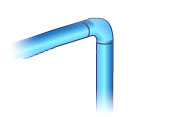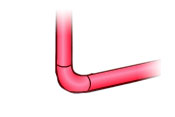Stop valve
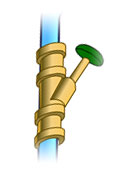 This serves to shut off the entire drinking water installation or at least individual sections of the pipes. Repair and maintenance work can involve having to shut off the supply. The pipes can be shut off centrally, for example at the cellar distribution point in the main supply connection room or in an apartment itself. The most common form of stop valve is an outlet valve but also piston valves and ball cocks. schliesen
This serves to shut off the entire drinking water installation or at least individual sections of the pipes. Repair and maintenance work can involve having to shut off the supply. The pipes can be shut off centrally, for example at the cellar distribution point in the main supply connection room or in an apartment itself. The most common form of stop valve is an outlet valve but also piston valves and ball cocks. schliesenWater meter
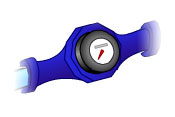 It serves to measure water consumption for a house or an apartment. In houses it is installed at the point at which the water pipes enter the house. In houses divided into several apartments where the water consumption is invoiced per apartment the meter is installed at the end of the respective water pipe at the respective point of delivery or in the apartment at the feeder to the drinking water rise pipe.
It serves to measure water consumption for a house or an apartment. In houses it is installed at the point at which the water pipes enter the house. In houses divided into several apartments where the water consumption is invoiced per apartment the meter is installed at the end of the respective water pipe at the respective point of delivery or in the apartment at the feeder to the drinking water rise pipe. In accordance with calibration laws the water meter must be recalibrated every six and five years in the case of warm water and cold water respectively. The year in which the meter was calibrated is recognizable by the anti-tamper seal. On one side the year is imprinted and on the other the identification number of the testing laboratory or the measurement office. schliesen
Stop valve with integrated backflow prevention device
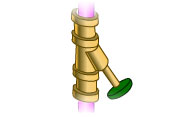 makes it possible to shut off the pipe, do maintenance work on the pump and prevents hot water being run off from the circulation pipe system. Once a year it should be inspected to ensure it works properly. schliesen
makes it possible to shut off the pipe, do maintenance work on the pump and prevents hot water being run off from the circulation pipe system. Once a year it should be inspected to ensure it works properly. schliesenFrost-proof garden tap with backflow prevention device
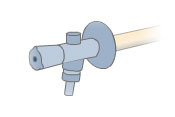 The frost-proof stop valve is installed between the indoor and outdoor area of buildings so that water can be removed for watering and cleaning purposes. As it is frost-proof the fitting ensures water can be removed the entire year round in the outdoor/ garden area. It is not necessary at the start of the frost period to let off water in the feeder to the fitting. The run off taps are fitted with screw-on tubing and can be protected against unauthorized run-off of water either by activating a key or removing the operating handle. schliesen
The frost-proof stop valve is installed between the indoor and outdoor area of buildings so that water can be removed for watering and cleaning purposes. As it is frost-proof the fitting ensures water can be removed the entire year round in the outdoor/ garden area. It is not necessary at the start of the frost period to let off water in the feeder to the fitting. The run off taps are fitted with screw-on tubing and can be protected against unauthorized run-off of water either by activating a key or removing the operating handle. schliesenCombined filter / pressure reducing valve (PRV)
 Filter:
Filter: protects the drinking water system against contamination (e.g., by grains of sand or particles of rust), which can cause corrosion damage. Installing a filter – either a fine filter or a backwash filter is recognized technical practice and mandatory. The filter should be rinsed every two months, a fine filter should be exchanged every six months.
Pressure reducer:
In the drinking water system its job is to reduce the high pressure in the connecting pipe to the drinking water system to the maximum admissible working pressure of 5 bar and reduce the amount of water running out at the point of delivery (tap). Pressure reducing valves are generally installed centrally in the cold water piping down the line from the water meter. schliesen
Leak protection system
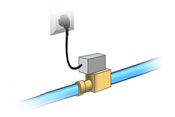 protects the building from water damage and complements the drinking water system after the domestic supply. Water damage is prevented as any leaks that might occur are identified at an early stage and consequently the drinking water plumbing is automatically switched off by the leak protection system. schliesen
protects the building from water damage and complements the drinking water system after the domestic supply. Water damage is prevented as any leaks that might occur are identified at an early stage and consequently the drinking water plumbing is automatically switched off by the leak protection system. schliesenWater softening system
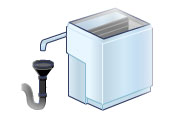 OPTIONAL: Is recommended in some regions if the house is located in a water supply area with hard water. Depending on the technology employed a chemical or physics reaction counters furring of the drinking water system and household appliances connected to the water system. It reduces the amount of soap or cleaning agent required. Regular maintenance is essential. The water softening system is equipped with a safety device (e.g., a system break), so that it can be connected to the drinking water system. schliesen
OPTIONAL: Is recommended in some regions if the house is located in a water supply area with hard water. Depending on the technology employed a chemical or physics reaction counters furring of the drinking water system and household appliances connected to the water system. It reduces the amount of soap or cleaning agent required. Regular maintenance is essential. The water softening system is equipped with a safety device (e.g., a system break), so that it can be connected to the drinking water system. schliesenDosing device
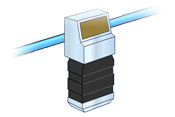 OPTIONAL: Should be selected together with the plumber in some instances if the house is in a water supply area with hard or aggressive water. It adds mineral substances to the drinking water, which act as corrosion protection and counter the formation of lime scale. It also makes it possible to increase the ph value. Dosing hinges on the water quality and piping material and takes the form of liquid concentrates. Dosing devices should be regularly inspected and maintained once a year. schliesen
OPTIONAL: Should be selected together with the plumber in some instances if the house is in a water supply area with hard or aggressive water. It adds mineral substances to the drinking water, which act as corrosion protection and counter the formation of lime scale. It also makes it possible to increase the ph value. Dosing hinges on the water quality and piping material and takes the form of liquid concentrates. Dosing devices should be regularly inspected and maintained once a year. schliesenWC cistern
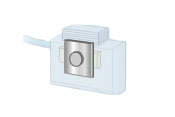 The cistern is used to store water for flushing the toilet. It comes either as a concealed version or a model in front of the wall. The cistern is operated by pushing a lever, and can also be fitted with an economy function (3 or 6 instead of 9 liters flushing water) or an electronic toilet control system. The cistern fills up again after use. schliesen
The cistern is used to store water for flushing the toilet. It comes either as a concealed version or a model in front of the wall. The cistern is operated by pushing a lever, and can also be fitted with an economy function (3 or 6 instead of 9 liters flushing water) or an electronic toilet control system. The cistern fills up again after use. schliesenCorner regulating valve
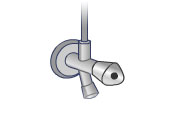 shuts off the drinking water flow before it reaches the wash basin faucet, for dismantling, servicing or repair purposes. schliesen
shuts off the drinking water flow before it reaches the wash basin faucet, for dismantling, servicing or repair purposes. schliesenShower head with hose
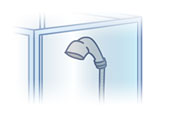 As opposed to fixed shower heads the hand-held version can be removed from its mounting and used for intense cleansing of specific parts of the body. Modern hand-held shower heads boast different settings for the flow of water and intensity of the jet of water; the different functions can be set using a revolving ring on the shower head. Several shower heads feature a massage function, which involves the water flowing in a thicker jet and under greater pressure. schliesen
As opposed to fixed shower heads the hand-held version can be removed from its mounting and used for intense cleansing of specific parts of the body. Modern hand-held shower heads boast different settings for the flow of water and intensity of the jet of water; the different functions can be set using a revolving ring on the shower head. Several shower heads feature a massage function, which involves the water flowing in a thicker jet and under greater pressure. schliesenSanitary tap
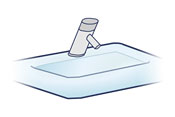 Depending on the version, water is sourced from a single-lever mixer or dual lever tap with or without electronic control. schliesen
Depending on the version, water is sourced from a single-lever mixer or dual lever tap with or without electronic control. schliesenKitchen tap
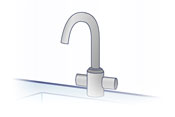 Depending on the version, water is sourced from a single-lever mixer or dual lever tap with or without electronic control. schliesen
Depending on the version, water is sourced from a single-lever mixer or dual lever tap with or without electronic control. schliesenHose union tap
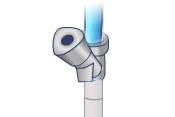 Wall fitting with safety device against backflow with stop valve and screw-on connection for plumbing in washing machines or similar appliances. schliesen
Wall fitting with safety device against backflow with stop valve and screw-on connection for plumbing in washing machines or similar appliances. schliesenDrinking water heating
system / drinking water tank
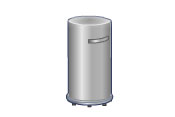 makes hot water from cold water and stores the hot water until it is used. schliesen
makes hot water from cold water and stores the hot water until it is used. schliesenFilling combination for filling the heating system
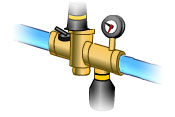 It is connected to the heating piping system, is always closed and is only opened when water needs to be added to the heating system. There is an integrated safety device to prevent heating water from coming into contact with drinking water. schliesen
It is connected to the heating piping system, is always closed and is only opened when water needs to be added to the heating system. There is an integrated safety device to prevent heating water from coming into contact with drinking water. schliesenDouble lever run-off
mixing tap
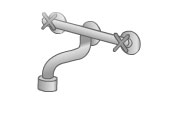 for running off cold or hot water or a mixture of cold and hot water. schliesen
for running off cold or hot water or a mixture of cold and hot water. schliesenStop valve for filling the heating system
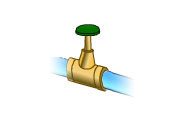 It is always closed and is only opened when water needs to be added to the heating system. schliesen
It is always closed and is only opened when water needs to be added to the heating system. schliesenCirculation pump
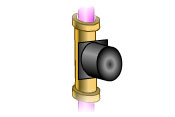 makes the hot water move and circulate to the run-off taps in bathroom and kitchen. The advantage of circulating hot water is that hot water runs out immediately on opening the taps and drinking water hygiene is maintained in the hot water system. schliesen
makes the hot water move and circulate to the run-off taps in bathroom and kitchen. The advantage of circulating hot water is that hot water runs out immediately on opening the taps and drinking water hygiene is maintained in the hot water system. schliesenPrewall installation
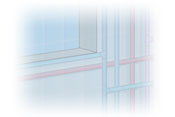 is required to maintain sound insulation in buildings. Drinking water and waste water systems are installed in the pre-wall elements, which are installed in front of the wall, secured and sealed. schliesen
is required to maintain sound insulation in buildings. Drinking water and waste water systems are installed in the pre-wall elements, which are installed in front of the wall, secured and sealed. schliesenDrinking water - circulation
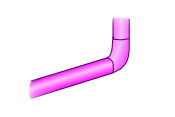 serves to keep the temperature warm and makes the drinking water circulate – warm. schliesen
serves to keep the temperature warm and makes the drinking water circulate – warm. schliesenRegulating valve for drinking water circulation
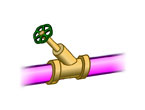 ensures that the circulating hot water always reaches all those areas where hot water is needed. schliesen
ensures that the circulating hot water always reaches all those areas where hot water is needed. schliesenStop valve with integrated backflow prevention device
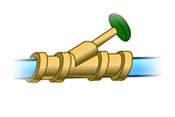 This valve makes it possible to close the plumbing and when it is open it prevents water from the domestic system from flowing back into the public supply network, which could cause considerable hygiene problems. Installing a backflow prevention device behind the water meter is mandatory. Once a year the valve must be checked to ensure it is working properly. schliesen
This valve makes it possible to close the plumbing and when it is open it prevents water from the domestic system from flowing back into the public supply network, which could cause considerable hygiene problems. Installing a backflow prevention device behind the water meter is mandatory. Once a year the valve must be checked to ensure it is working properly. schliesenDiaphragm safety valve / safety group
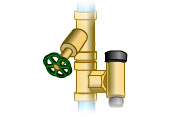 protects against too high pressure in the hot water and in the drinking water heater (closed drinking water container) and prevents the drinking water heater from exploding. High pressure occurs when cold water in a closed container is heated to a temperature of up to 60°C. schliesen
protects against too high pressure in the hot water and in the drinking water heater (closed drinking water container) and prevents the drinking water heater from exploding. High pressure occurs when cold water in a closed container is heated to a temperature of up to 60°C. schliesenThe water pipe – underestimated technology
Drinking water is our most important foodstuff.The requirements to the drinking water quality are legally controlled in the revised drinking water regulation from 1st November 2011.
For water to be suitable for drinking, cooking, and washing it must satisfy stringent requirements in terms of its chemical contents and microbiological composition, as the enjoyment or use of drinking water must not endanger a person’s health. It therefore needs to be free of pathogenic germs and the sort of chemical substances that can cause illness. Drinking water should also be an enjoyment, in other words be colorless, clear, cool and impeccable in terms of odor and taste.
On its journey from the entrance to the building to the tapping point, drinking water comes into contact with various materials (pipes, valves etc.). However, the quality of the drinking water must not be impaired. Though the Drinking Water Decree does not stipulate the use of specific materials the selection of materials is discussed. If the generally recognized technical rules are adhered to in planning, constructing, and operating of a drinking water installation, the requirements of materials are considered met. The former are outlined in standards and regulations.
As of the point at which drinking water enters a building, the owner or landlord is responsible for its quality. As these, as a rule, are unfamiliar with the requirements of a drinking water installation, planning, construction, and regular servicing should in every case be left to a specialist company.
Get more information from our new internet platform www.trinkwasser-wissen.net especially to the intensified obligations for facility operators and homeowners since the revised drinking water regulation from 1st November 2011. schliesen
Stop valve
 This serves to shut off the entire drinking water installation or at least individual sections of the pipes. Repair and maintenance work can involve having to shut off the supply. The pipes can be shut off centrally, for example at the cellar distribution point in the main supply connection room or in an apartment itself. The most common form of stop valve is an outlet valve but also piston valves and ball cocks. schliesen
This serves to shut off the entire drinking water installation or at least individual sections of the pipes. Repair and maintenance work can involve having to shut off the supply. The pipes can be shut off centrally, for example at the cellar distribution point in the main supply connection room or in an apartment itself. The most common form of stop valve is an outlet valve but also piston valves and ball cocks. schliesenWater meter
 It serves to measure water consumption for a house or an apartment. In houses it is installed at the point at which the water pipes enter the house. In houses divided into several apartments where the water consumption is invoiced per apartment the meter is installed at the end of the respective water pipe at the respective point of delivery or in the apartment at the feeder to the drinking water rise pipe.
It serves to measure water consumption for a house or an apartment. In houses it is installed at the point at which the water pipes enter the house. In houses divided into several apartments where the water consumption is invoiced per apartment the meter is installed at the end of the respective water pipe at the respective point of delivery or in the apartment at the feeder to the drinking water rise pipe. In accordance with calibration laws the water meter must be recalibrated every six and five years in the case of warm water and cold water respectively. The year in which the meter was calibrated is recognizable by the anti-tamper seal. On one side the year is imprinted and on the other the identification number of the testing laboratory or the measurement office. schliesen
Garden taps with safety
device to prevent backflow
 These are stop valves installed in the outdoor area of buildings so that water can be run off for watering or cleaning. Normally run-off taps with screw-on tubing are used, which are fitted with a key or removable operating lever to protect against unauthorized use. schliesen
These are stop valves installed in the outdoor area of buildings so that water can be run off for watering or cleaning. Normally run-off taps with screw-on tubing are used, which are fitted with a key or removable operating lever to protect against unauthorized use. schliesenCombined filter / pressure reducing valve (PRV)
 Filter:
Filter: protects the drinking water system against contamination (e.g., by grains of sand or particles of rust), which can cause corrosion damage. Installing a filter – either a fine filter or a backwash filter is recognized technical practice and mandatory. The filter should be rinsed every two months, a fine filter should be exchanged every six months.
Pressure reducing valve (PRV) :
In the drinking water system its job is to reduce the high pressure in the connecting pipe to the drinking water system to the maximum admissible working pressure of 5 bar and reduce the amount of water running out at the point of delivery (tap). Pressure reducing valves are generally installed centrally in the cold water piping down the line from the water meter. schliesen
WC cistern
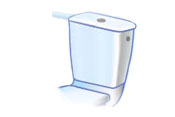 The cistern is used to store water for flushing the toilet. It comes either as a concealed version or a model in front of the wall. The cistern is operated by pushing a lever, and can also be fitted with an economy function (3 or 6 instead of 9 liters flushing water) or an electronic toilet control system. The cistern fills up again after use. schliesen
The cistern is used to store water for flushing the toilet. It comes either as a concealed version or a model in front of the wall. The cistern is operated by pushing a lever, and can also be fitted with an economy function (3 or 6 instead of 9 liters flushing water) or an electronic toilet control system. The cistern fills up again after use. schliesenCorner regulating valve
 shuts off the drinking water flow before it reaches the wash basin faucet, for dismantling, servicing or repair purposes. schliesen
shuts off the drinking water flow before it reaches the wash basin faucet, for dismantling, servicing or repair purposes. schliesenShower head with hose
 As opposed to fixed shower heads the hand-held version can be removed from its mounting and used for intense cleansing of specific parts of the body. Modern hand-held shower heads boast different settings for the flow of water and intensity of the jet of water; the different functions can be set using a revolving ring on the shower head. Several shower heads feature a massage function, which involves the water flowing in a thicker jet and under greater pressure. schliesen
As opposed to fixed shower heads the hand-held version can be removed from its mounting and used for intense cleansing of specific parts of the body. Modern hand-held shower heads boast different settings for the flow of water and intensity of the jet of water; the different functions can be set using a revolving ring on the shower head. Several shower heads feature a massage function, which involves the water flowing in a thicker jet and under greater pressure. schliesenSanitary tap
 Depending on the version, water is sourced from a single-lever mixer or dual lever tap with or without electronic control. schliesen
Depending on the version, water is sourced from a single-lever mixer or dual lever tap with or without electronic control. schliesenKitchen tap
 Depending on the version, water is sourced from a single-lever mixer or dual lever tap with or without electronic control. schliesen
Depending on the version, water is sourced from a single-lever mixer or dual lever tap with or without electronic control. schliesenHose union tap
 Wall fitting with safety device against backflow with stop valve and screw-on connection for plumbing in washing machines or similar appliances. schliesen
Wall fitting with safety device against backflow with stop valve and screw-on connection for plumbing in washing machines or similar appliances. schliesenDrinking water heating
system / drinking water tank
 makes hot water from cold water and stores the hot water until it is used. schliesen
makes hot water from cold water and stores the hot water until it is used. schliesenDouble lever run-off
mixing tap
 for running off cold or hot water or a mixture of cold and hot water. schliesen
for running off cold or hot water or a mixture of cold and hot water. schliesenRun-off fitting
 serves to fill the heating system and if required is attached temporarily via tubing to the heating fitting valve. schliesen
serves to fill the heating system and if required is attached temporarily via tubing to the heating fitting valve. schliesenStop valve for filling the heating system
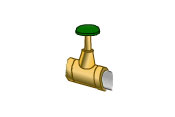 It is always closed and is only opened when water needs to be added to the heating system. schliesen
It is always closed and is only opened when water needs to be added to the heating system. schliesenDiaphragm safety valve / safety group
 protects against too high pressure in the hot water and in the drinking water heater (closed drinking water container) and prevents the drinking water heater from exploding. High pressure occurs when cold water in a closed container is heated to a temperature of up to 60°C. schliesen
protects against too high pressure in the hot water and in the drinking water heater (closed drinking water container) and prevents the drinking water heater from exploding. High pressure occurs when cold water in a closed container is heated to a temperature of up to 60°C. schliesenStop valve with drain function
 makes it possible to shut off the pipe to the garden watering tap. To prevent frost damage the stop valve is closed in autumn before the frost period begins and the garden watering pipes are emptied. schliesen
makes it possible to shut off the pipe to the garden watering tap. To prevent frost damage the stop valve is closed in autumn before the frost period begins and the garden watering pipes are emptied. schliesenStop valve with integrated backflow prevention device
 This valve makes it possible to close the plumbing and when it is open it prevents water from the domestic system from flowing back into the public supply network, which could cause considerable hygiene problems. Installing a backflow prevention device behind the water meter is mandatory. Once a year the valve must be checked to ensure it is working properly. schliesen
This valve makes it possible to close the plumbing and when it is open it prevents water from the domestic system from flowing back into the public supply network, which could cause considerable hygiene problems. Installing a backflow prevention device behind the water meter is mandatory. Once a year the valve must be checked to ensure it is working properly. schliesenThe water pipe – underestimated technology
Drinking water is our most important foodstuff.The requirements to the drinking water quality are legally controlled in the revised drinking water regulation from 1st November 2011.
For water to be suitable for drinking, cooking, and washing it must satisfy stringent requirements in terms of its chemical contents and microbiological composition, as the enjoyment or use of drinking water must not endanger a person’s health. It therefore needs to be free of pathogenic germs and the sort of chemical substances that can cause illness. Drinking water should also be an enjoyment, in other words be colorless, clear, cool and impeccable in terms of odor and taste.
On its journey from the entrance to the building to the tapping point, drinking water comes into contact with various materials (pipes, valves etc.). However, the quality of the drinking water must not be impaired. Though the Drinking Water Decree does not stipulate the use of specific materials the selection of materials is discussed. If the generally recognized technical rules are adhered to in planning, constructing, and operating of a drinking water installation, the requirements of materials are considered met. The former are outlined in standards and regulations.
As of the point at which drinking water enters a building, the owner or landlord is responsible for its quality. As these, as a rule, are unfamiliar with the requirements of a drinking water installation, planning, construction, and regular servicing should in every case be left to a specialist company.
Get more information from our new internet platform www.trinkwasser-wissen.net especially to the intensified obligations for facility operators and homeowners since the revised drinking water regulation from 1st November 2011. schliesen

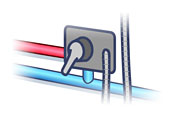 This enables the desired temperature to be pre-set.
This enables the desired temperature to be pre-set. 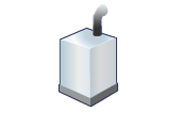 serves to heat the house and heat drinking water. Generally fueled by oil or gas.
serves to heat the house and heat drinking water. Generally fueled by oil or gas. 